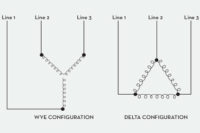
Voltage unbalance is defined by the National Electrical Manufacturers Association (NEMA) as 100 times the absolute value of the maximum deviation of the line voltage from the average voltage on a three-phase system, divided by the average voltage. For example, if the measured line voltages are 462, 463, and 455 volts, the average is 460 volts. The voltage unbalance is:
(460 - 455)/460 x 100 = 1.1 percent
It is recommended that the voltage unbalances at the motor terminals not exceed 1 percent. Unbalances over 1 percent require derating of the motor per Figure 20-2 of NEMA MG-1-2003, Revision 1-2004, and will void most manufacturers’ warranties. Common causes of voltage unbalance include:
• Faulty operation of power factor correction equipment.
• Unbalanced or unstable utility supply.
• Unbalanced transformer bank supplying a three-phase load that is too large for the bank.
• Unevenly distributed single-phase loads on the same power system.
• Unidentified single-phase to ground faults.
• An open circuit on the distribution system primary.
The efficiency of a rewound, 1,800-rpm, 100-hp motor is given as a function of voltage unbalance and motor load in the table. The general trend of efficiency reduction with increased voltage unbalance is observed for all motors at all load conditions.
Voltage unbalance is probably the leading power quality problem that results in motor overheating and premature motor failure. If unbalanced voltages are detected, a thorough investigation should be undertaken to determine the cause. Energy and dollar savings occur when corrective actions are taken.
EXAMPLE
Assume that the motor tested as shown in the above table was fully loaded and operated for 8,000 hours per year, with an unbalanced voltage of 2.5 percent. With energy priced at $0.05/kWh, the annual energy and dollar savings, after corrective actions are taken, are:Annual Energy Savings= 100 hp x 0.746 kW/hp x 8,000 hrs/yr x (100/93 – 100/94.4) = 9,517 kWh
Annual Dollar Savings= 9,517 kWh x $0.05/kWh = $476
Overall savings may be much larger because an unbalanced supply voltage may power numerous motors.
FURTHER CONSIDERATIONS
Voltage unbalance causes extremely high current unbalance. The magnitude of current unbalance may be 6 to 10 times as large as the voltage unbalance. For the 100-hp motor in this example, line currents (at full-load with 2.5 percent voltage unbalance) were unbalanced by 27.7 percent.A motor will run hotter when operating on a power supply with voltage unbalance. The additional temperature rise is estimated with the following equation: Percent additional temperature rise = 2 x (percent voltage unbalance)2. For example, a motor with a 100°C temperature rise would experience a temperature increase of 8°C when operated under conditions of 2 percent voltage unbalance. Winding insulation life is reduced by one-half for each 10°C increase in operating temperature.
Suggested Actions
• Regularly monitor voltages at the motor terminals to verify that voltage unbalance is maintained below 1 percent.• Check electrical system single-line diagrams to verify that single-phase loads are uniformly distributed.
• Install ground fault indicators as required and perform annual thermographic inspections. Another indicator that voltage unbalance may be a problem is 120 Hz vibration. A finding of 120 Hz vibration should prompt an immediate check of voltage balance.
Resources
National Electrical Manufacturers Association (NEMA)- Visit www.nema.org for additional information on voltage unbalance.U.S. Department of Energy- DOE’sMotorMaster+andMotorMaster+ Internationalsoftware tools help you make motor comparisons and selection on a broad range of motors.
Visit the BestPractices Website at www.eere.energy.gov/industry/bestpractices to access various energy efficiency resources.
Reprinted from Motor Systems Tip Sheet #7, “Eliminate Voltage Unbalance,” from the U.S. Department of Energy’s Office of Energy Efficiency and Renewable Energy. For more information, visit www.eere.energy.gov.
Publication date:06/22/2009








